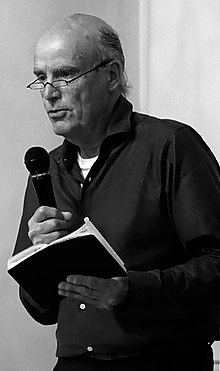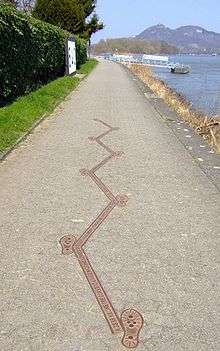Hamish Fulton
Hamish Fulton (born 1946) is an English walking artist. Since 1972 he has only made works based on the experience of walks.[1] He translates his walks into a variety of media, including photography, illustrations, and wall texts. His work is contained in major museums collections, such as the Tate Britain and MoMA.[2] Since 1994 he has begun practicing group walks.[3] Fulton argues that 'walking is an artform in its own right' and argues for wider acknowledgement of walking art.[4]

Biography
He first attended the art foundation course at Hammersmith College of Art. With help from a tutor (David Hall) he was accepted straight into the advanced course at Saint Martin's School of Art, London, 1966–68, and the following year studied at the Royal College of Art, London.[5]

Fulton follows a leave no trace ethic, and does not collect materials on his walks for display in galleries. Instead, his work combines text-based descriptions with a photograph, illustration, or, more recently, vinyl wall texts, to communicate his walks to viewers in a gallery.[6][7] Fulton has stated that walking is an experience not an art medium, and that what he builds is an experience, not a sculpture.[8] More recently, Fulton has referred to his walks as 'invisible objects' and has discussed his group walks as artworks that are created and observed by the participants.[1] Fulton has emphasised the political aspects of his work,[9] particularly in concern to the situation in Tibet and the degradation of the environment.[4]
In 1994, Fulton first experimented with the creation of group walks while working side-by-side with Marina Abramović at CCA Kitakyushu. He has created a variety of group walks since, including Slowalk (in Support of Ai Weiwei) (2011) in the Turbine Hall at the Tate Modern to bring attention to the restrictions on artist Ai Weiwei's freedom of travel and artistic production.[3][10] In 2002 he worked with artist Christine Quoiraud on a series of group walks in France.[11]:59 Since working with Quoiraud, Fulton has adopted her style of equi-spaced walking during his group walks.[12]
In 2010, Deveron Projects commissioned Fulton to create 21 Days in the Cairngorms, which included two group walks in Huntly, Scotland.[11]:55 [13]:3 This project continued Fulton's engagement with the Cairngorms, where he previously created a number of walking works,[10] and resulted in the book Mountain Time, Human Time (2010).[14] Zeiske, the director of Deveron Projects, cites Fulton as the inspiration for the establishment of The Walking Institute, which has continued to develop artistic projects based in walking.[13]:3
Solo exhibitions
- Hamish Fulton - A Decision to Choose Only Walking (2016) Galerie Tschudi - Zuoz, Zuoz, Switzerland
- Hamish Fulton: Wells of Dee (2015) Galleri Riis, Stockholm, Sweden
- Walking Transformation (2014) Villa Merkel, Esslingen Am Neckar, Germany
Publications
- Hamish Fulton (2010) Mountain Time, Human Time. Charta: Milano.
- Fulton, H. (2012) Walking in Relation to Everything. Ikon Gallery: Birmingham.
- Hamish Fulton (2000) Magpie: Two River Walks. Lethbridge: Southern Alberta Art Gallery.
- Hamish Fulton. (2000b) Wild Life: a Walk in the Cairngorms. Edinburgh: Pocketbooks.
- Camp Fire. Stedelijk Van Abbemuseum, Eindhoven. 1985. ISBN 90-70149-11-7
References
- Fulton, Hamish (2007). Interview with Peter Lodermeyer for Personal Structure (PDF). Time-Space-Existence. p. 181.
- "Hamish Fulton | MoMA". The Museum of Modern Art. Retrieved 2016-07-06.
- St.Moritz Art Masters (2012-08-31), St.Moritz Art Masters 2012 - Hamish Fulton Artist Talk, retrieved 2016-07-06
- Watkins, Jonathan; Pomery, Victoria (2012-02-28). Walking in Relation to Everything: Hamish Fulton. Ikon Gallery Ltd. ISBN 9781904864745. ASIN 1904864740.
- Oxford Art Online
- Bevan, Roger (1990). "Hamish Fulton. Mexico City". The Burlington Magazine. 132 (1047): 440–441.
- Boetzkes, Amanda (2010). The Ethics of Earth Art. Minneapolis: University of Minnesota Press. p. 60.
- Heddon, Deirdre; Klein, Jennie (2012-12-07). Histories and Practices of Live Art. Palgrave Macmillan. p. 98. ISBN 9781137272317.
- Bellet, Propos recueillis par Harry (2010-06-08). "Pour Hamish Fulton, la création artistique naît de la pratique intensive de la marche". Le Monde.fr (in French). ISSN 1950-6244. Retrieved 2016-07-06.
- Macpherson, Alan (2017-03-01). "'Sensuous Singularity': Hamish Fulton's Cairngorm Walk-Texts". Critical Survey. 29 (1): 12–32. doi:10.3167/cs.2017.290102. hdl:2164/11978. ISSN 0011-1570. Archived from the original on 2018-06-02.
- Morris, Blake (2019-11-05). Walking Networks: The Development of an Artistic Medium. Rowman & Littlefield International. ISBN 978-1-78661-022-5.CS1 maint: date and year (link)
- Quoiraud, Christine; Fulton, Hamish (2003-05-19). Walk Dance Art C° (in French). Trézélan: Filigranes Editions. ISBN 9782914381512. ASIN 2914381514.
- Deveron Projects. "Walking Institute: Vision Document" (PDF). Retrieved 11 Feb 2020.
- Fulton, Hamish (2010). Mountain Time Human Time. Edizioni Charta. ISBN 9788881587919.
External links
- Artist Website
- Maureen Paley Website
- Galerie van der Mieden Website
- Wall installation at John Weber Gallery
- Examples of the 'fulton' Visual poetry form
- TateShots: Hamish Fulton's Slowalk (in support of Ai Weiwei) on YouTube Footage from the artist's participatory performance piece at Tate Modern. 1 May 2011